Bailleul Communal Cemetery Extension
Roll of Honour
I - Q
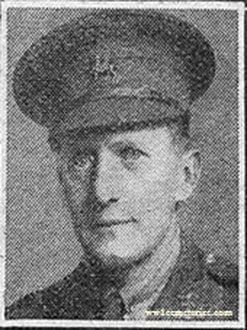
Captain
Pryce Attwood Clive Kelsey
6th Bn. The Buffs (East Kent Regiment)
26th July 1915.
Plot I. D. 32.
Pryce Attwood Clive Kelsey
6th Bn. The Buffs (East Kent Regiment)
26th July 1915.
Plot I. D. 32.
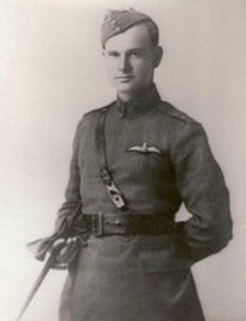
Second Lieutenant
Homer Warring Laird
Royal Flying Corps.
8th October 1917
Plot III. E. 115.
His father Henry Willoughby Laird, lieutenant colonel, CEF, and at the start of the war; major in the Army Service Corps and brother Lieutenant William Clarence Laird, CEF, both survived the war. They will always be remembered and in our family's thought and prayers.
Picture courtesy of Jousette Giffen, great, great niece
Homer Warring Laird
Royal Flying Corps.
8th October 1917
Plot III. E. 115.
His father Henry Willoughby Laird, lieutenant colonel, CEF, and at the start of the war; major in the Army Service Corps and brother Lieutenant William Clarence Laird, CEF, both survived the war. They will always be remembered and in our family's thought and prayers.
Picture courtesy of Jousette Giffen, great, great niece

8442 Serjeant
Robert Leggat
9th Bn. Cameronians, (Scottish Rifles)
30/03/1916.
Plot II. B. 46.
Robbie was a Serjeant in the 9th Battalion, Cameronians (Scottish Rifles) and was a professional soldier having enlisted prior to 1906. He was killed on 29 or 30 March 1916 while leading his men when a hand grenade blew up in his hand. His grave is at Bailleul Communal Cemetery Extension.
Picture courtesy of great niece, Maureen Drake
Robert Leggat
9th Bn. Cameronians, (Scottish Rifles)
30/03/1916.
Plot II. B. 46.
Robbie was a Serjeant in the 9th Battalion, Cameronians (Scottish Rifles) and was a professional soldier having enlisted prior to 1906. He was killed on 29 or 30 March 1916 while leading his men when a hand grenade blew up in his hand. His grave is at Bailleul Communal Cemetery Extension.
Picture courtesy of great niece, Maureen Drake
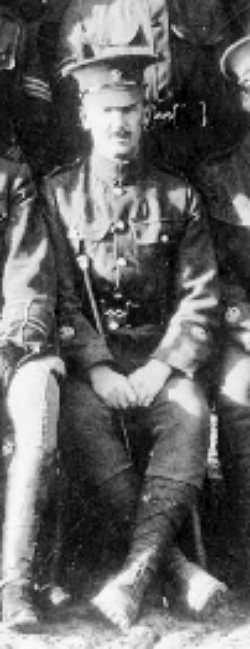
530438 Regimental Sergeant Major
Harold William Lovelock, M. S. M.
15th Bn. London Regiment (Prince of Wales' Own Civil Service Rifles)
28th September 1918, aged 38.
Plot III. G. 59.
Son of Raymond William and Jane Maria Lovelock, of London; husband of Isabel Sophia Lovelock, of 9, Beaufort Mansions, Chelsea, London. Clerk in The Bank of England.
His headstone bears the inscription "There Is Some Corner Of A Foreign Field That Is Forever England"
The information below supplied by 'The Ellesmerian Club', the alumni organisation for Ellesmere College where Harold was a pupil.
Harold William Lovelock, M. S. M.
15th Bn. London Regiment (Prince of Wales' Own Civil Service Rifles)
28th September 1918, aged 38.
Plot III. G. 59.
Son of Raymond William and Jane Maria Lovelock, of London; husband of Isabel Sophia Lovelock, of 9, Beaufort Mansions, Chelsea, London. Clerk in The Bank of England.
His headstone bears the inscription "There Is Some Corner Of A Foreign Field That Is Forever England"
The information below supplied by 'The Ellesmerian Club', the alumni organisation for Ellesmere College where Harold was a pupil.
Harold William Lovelock, the only son of Raymond William Lovelock, a bank clerk, and his wife, Jane Maria, was born on 9th May 1880 in West Derby, Liverpool when the family lived at Newham Terrace. The family was completed with the births of Marjorie (1883) and Dorothy (1885).
Little is known of Harold’s early childhood apart from the fact that he attended the Liverpool Institute for the three years prior to his admittance to the ‘Alfred’ dormitory at Ellesmere College on 15th September 1893. Thirty-one new boys arrived in north Shropshire that term and many of them served in uniform when the call to arms came. One of Harold’s direct contemporaries was George A. D. Harvey who was “one of the five brothers who arrived at Ellesmere at the end of the 19th Century and who were the most outstanding, and by far the ablest family group educated at this school”.
Harold boarded for just over two years at a time when there were one hundred and seventy-four on the nominal roll. He was initially placed in Form Lower IV under the tutelage of Rev. B. R. Hibbert, himself an Old Ellesmerian who had been admitted the very first term the college opened in September 1884. There are no academic records of his time at Ellesmere available but The Ellesmerian records his involvement out on the playing field where he played cricket and rugby for his dormitory team – in the latter sport a team mate was T. A Harvey who, by 1900, was playing for Ireland. On Sports Day 1894 he took 1st place in the Choir Probationers Race and the following year saw him take 2nd place 'Throwing the Cricket Ball’ with a distance of just over 63 yards. He also took 2nd place in the High Jump but conditions were far from ideal “jumping off wet ground was a matter of great difficulty”.
Harold left Ellesmere in December 1895 and soon moved to London where he took up employment as a clerk in the Consol’s Department, the Bank of England. He became involved with the Territorial Army, enlisting in the Middlesex Civil Service Rifles, Bank of England Company. By 1904, he had been promoted Corporal and The Ellesmerian (June 1904) reported that “He was selected as a member of the Guard of Honour at the Duke of Cambridge’s funeral in March last”. The magazine also recorded that he played rugby for Upper Clapton 1stXV Rugby team. He was also Captain of the Bank’s Rugby Team in the 1902 season.
In 1909, at the Brompton Oratory, Harold married Isabel Sophie Campbell and they went on to have three children Robert, Raymond and Margaret. The 1911 Census recorded them living at 66, Harvard Court, West Hampstead and that Harold was still employed at the bank.
With the outbreak of war, Harold’s previous military experience would have been invaluable, especially in the training of new recruits, and it was not until 23rd June 1916 that he embarked for his first active service overseas in France & Belgium where he remained until 19th November. At the end of November, he embarked for a longer sea voyage to take part in the Greek and Macedonian campaigns. In June 1917 he travelled even further afield to serve in Egypt before returning to France on 23rd June 1918, where he met his death on 29thSeptember. In “The History of The Prince of Wales Civil Service Rifles” his Company’s movements are detailed on the day he died:
“During the late afternoon and the evening our advance companies pushed forward, meeting small resistance from the enemy’s rearguards. “A” Company on the left were able to push forward past Hospice Mill and actually entered the ruined village of Messines before midnight. The advance of “C” Company was necessarily slower as the troops on our right were held up, and it became necessary for us to form a defensive flank. Unfortunately, it was found inadvisable to hold the village of Messines, as the Battalion on our left had also met some strong resistance, and the salient which we formed became particularly unpleasant and it was ordered that we should withdraw from the village itself and occupy Hospice Mill, on the western outskirts, where “B” Company had pushed out in support of “A” Company during the advance to the village. In view of the advance being continued the following day, it was decided that “D” Company should relieve “A” Company in the front line, and “B” Company should continue as supports and “A” and “C” Companies be held in Battalion reserve. Great credit is due to all concerned for the excellent manner in which this reorganisation was carried out on such a dark night and over strange country covered with shell-holes, trenches and with entanglements. The first day’s work had been very successful.
Our casualties were comparatively small when one realises the advance we had made, and most of them were the result of heavy artillery fire which had continued all day on our old front line, and, curious as it may seem, Headquarters suffered most, one unlucky shell killing nine and wounding five others seriously. Amongst those killed by this shell was our R.S.M. H. W. Lovelock, well known to both the 1st and 2nd Battalions”.
Regimental Sergeant Major Harold William Lovelock, Service No. 530438 is buried in Bailleul Communal Cemetery Extension. Prior to his death he had been awarded the Meritorious Service Medal which was instigated to recognise an individual with “good, faithful, valuable and meritorious service, with conduct judged to be irreproachable throughout". During the war army NCO’s could be awarded the medal immediately for meritorious service in the field or for acts of non-combat gallantry. Harold’s medal was was “in recognition of valuable service rendered with the Armies in France and Flanders”.
Harold was also awarded the Victory Medal and the British War Medal. His life and sacrifice is commemorated on memorials at Ellesmere College, the Bank of England, the Liverpool Institute and at St. Agnes & St. Pancras Church.
Little is known of Harold’s early childhood apart from the fact that he attended the Liverpool Institute for the three years prior to his admittance to the ‘Alfred’ dormitory at Ellesmere College on 15th September 1893. Thirty-one new boys arrived in north Shropshire that term and many of them served in uniform when the call to arms came. One of Harold’s direct contemporaries was George A. D. Harvey who was “one of the five brothers who arrived at Ellesmere at the end of the 19th Century and who were the most outstanding, and by far the ablest family group educated at this school”.
Harold boarded for just over two years at a time when there were one hundred and seventy-four on the nominal roll. He was initially placed in Form Lower IV under the tutelage of Rev. B. R. Hibbert, himself an Old Ellesmerian who had been admitted the very first term the college opened in September 1884. There are no academic records of his time at Ellesmere available but The Ellesmerian records his involvement out on the playing field where he played cricket and rugby for his dormitory team – in the latter sport a team mate was T. A Harvey who, by 1900, was playing for Ireland. On Sports Day 1894 he took 1st place in the Choir Probationers Race and the following year saw him take 2nd place 'Throwing the Cricket Ball’ with a distance of just over 63 yards. He also took 2nd place in the High Jump but conditions were far from ideal “jumping off wet ground was a matter of great difficulty”.
Harold left Ellesmere in December 1895 and soon moved to London where he took up employment as a clerk in the Consol’s Department, the Bank of England. He became involved with the Territorial Army, enlisting in the Middlesex Civil Service Rifles, Bank of England Company. By 1904, he had been promoted Corporal and The Ellesmerian (June 1904) reported that “He was selected as a member of the Guard of Honour at the Duke of Cambridge’s funeral in March last”. The magazine also recorded that he played rugby for Upper Clapton 1stXV Rugby team. He was also Captain of the Bank’s Rugby Team in the 1902 season.
In 1909, at the Brompton Oratory, Harold married Isabel Sophie Campbell and they went on to have three children Robert, Raymond and Margaret. The 1911 Census recorded them living at 66, Harvard Court, West Hampstead and that Harold was still employed at the bank.
With the outbreak of war, Harold’s previous military experience would have been invaluable, especially in the training of new recruits, and it was not until 23rd June 1916 that he embarked for his first active service overseas in France & Belgium where he remained until 19th November. At the end of November, he embarked for a longer sea voyage to take part in the Greek and Macedonian campaigns. In June 1917 he travelled even further afield to serve in Egypt before returning to France on 23rd June 1918, where he met his death on 29thSeptember. In “The History of The Prince of Wales Civil Service Rifles” his Company’s movements are detailed on the day he died:
“During the late afternoon and the evening our advance companies pushed forward, meeting small resistance from the enemy’s rearguards. “A” Company on the left were able to push forward past Hospice Mill and actually entered the ruined village of Messines before midnight. The advance of “C” Company was necessarily slower as the troops on our right were held up, and it became necessary for us to form a defensive flank. Unfortunately, it was found inadvisable to hold the village of Messines, as the Battalion on our left had also met some strong resistance, and the salient which we formed became particularly unpleasant and it was ordered that we should withdraw from the village itself and occupy Hospice Mill, on the western outskirts, where “B” Company had pushed out in support of “A” Company during the advance to the village. In view of the advance being continued the following day, it was decided that “D” Company should relieve “A” Company in the front line, and “B” Company should continue as supports and “A” and “C” Companies be held in Battalion reserve. Great credit is due to all concerned for the excellent manner in which this reorganisation was carried out on such a dark night and over strange country covered with shell-holes, trenches and with entanglements. The first day’s work had been very successful.
Our casualties were comparatively small when one realises the advance we had made, and most of them were the result of heavy artillery fire which had continued all day on our old front line, and, curious as it may seem, Headquarters suffered most, one unlucky shell killing nine and wounding five others seriously. Amongst those killed by this shell was our R.S.M. H. W. Lovelock, well known to both the 1st and 2nd Battalions”.
Regimental Sergeant Major Harold William Lovelock, Service No. 530438 is buried in Bailleul Communal Cemetery Extension. Prior to his death he had been awarded the Meritorious Service Medal which was instigated to recognise an individual with “good, faithful, valuable and meritorious service, with conduct judged to be irreproachable throughout". During the war army NCO’s could be awarded the medal immediately for meritorious service in the field or for acts of non-combat gallantry. Harold’s medal was was “in recognition of valuable service rendered with the Armies in France and Flanders”.
Harold was also awarded the Victory Medal and the British War Medal. His life and sacrifice is commemorated on memorials at Ellesmere College, the Bank of England, the Liverpool Institute and at St. Agnes & St. Pancras Church.

Lieutenant
John Spokes Luckett
2nd Bn. Royal Irish Regiment
24th May 1915.
Plot I. F. 40.
John Spokes Luckett
2nd Bn. Royal Irish Regiment
24th May 1915.
Plot I. F. 40.
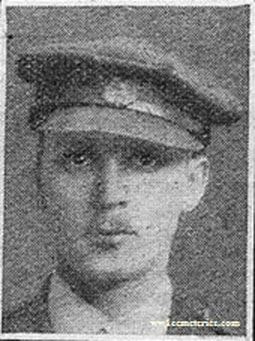
Captain
J. W. H. McCulloch
8th Bn. Border Regiment
21st October 1915.
Plot I. C. 125.
J. W. H. McCulloch
8th Bn. Border Regiment
21st October 1915.
Plot I. C. 125.
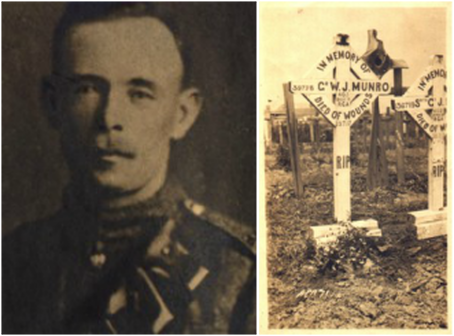
39728 Gunner
William James Munro
405th Siege Battery, Royal Garrison Artillery
29th July 1917, aged 28.
Plot III. D. 284.
Pictures courtesy of great granddaughter, Linda Cane
William James Munro
405th Siege Battery, Royal Garrison Artillery
29th July 1917, aged 28.
Plot III. D. 284.
Pictures courtesy of great granddaughter, Linda Cane

Captain
Gerard Arthur O'Callaghan
2nd Bn. Royal Irish Regiment
24th May 1915, aged 35.
Plot I. E. 157
Son of Major-General Sir Desmond O'Callaghan, K.C.V.O., Col. Cmdt. R.A. and the late Lady O'Callaghan, of 53, Iverna Court, Kensington, London W. Served in the South African War.
Gerard Arthur O'Callaghan
2nd Bn. Royal Irish Regiment
24th May 1915, aged 35.
Plot I. E. 157
Son of Major-General Sir Desmond O'Callaghan, K.C.V.O., Col. Cmdt. R.A. and the late Lady O'Callaghan, of 53, Iverna Court, Kensington, London W. Served in the South African War.
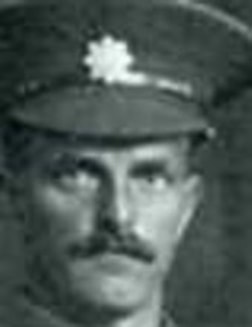
50987 Private
William Oliver
11th Bn. Cheshire Regiment
16th June 1917, aged 28.
Plot III. D. 33.
Son of Samuel and Elizabeth Oliver, of Thornbury; husband of Elsie May Oliver, of Forda, Thornbury, Brandis Corner, Devon.
Picture courtesy of Derek Whittall
William Oliver
11th Bn. Cheshire Regiment
16th June 1917, aged 28.
Plot III. D. 33.
Son of Samuel and Elizabeth Oliver, of Thornbury; husband of Elsie May Oliver, of Forda, Thornbury, Brandis Corner, Devon.
Picture courtesy of Derek Whittall
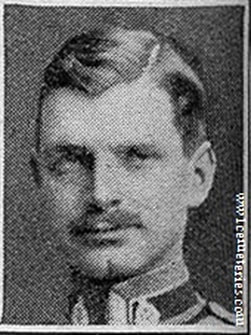
Lieutenant
Charles Pilter
18th (Queen Mary's Own) Hussars
30th May 1915, aged 27.
Plot I. E. 154.
Son of Robert and Kate Manwaring Pilter, of Neuilly-sur-Seine, Seine, France.
Charles Pilter
18th (Queen Mary's Own) Hussars
30th May 1915, aged 27.
Plot I. E. 154.
Son of Robert and Kate Manwaring Pilter, of Neuilly-sur-Seine, Seine, France.




